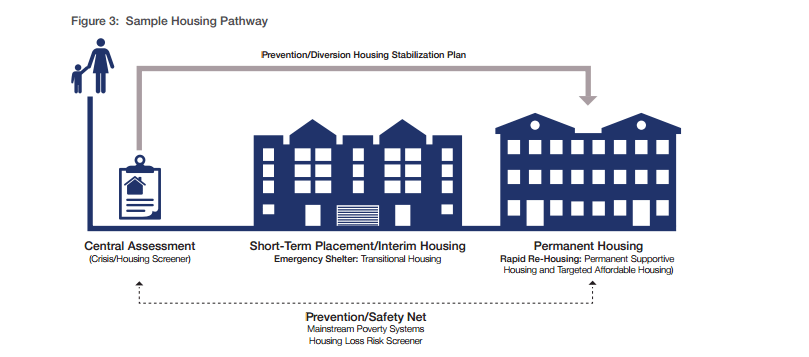The D.C. Interagency Council on Homelessness (ICH) strategic plan contains five “action items” in the intervention strategy for preventing homelessness. A year after the plan’s development, Street Sense thought an annual check-up was in order. ICH provided a status update for each point:
1. Implement targeted homelessness prevention programming that incorporates the use of predictive analytics tools and strategies.
The D.C. Department of Human Services (DHS) Family Homelessness Prevention Program (HPP) launched September 2015 with the goal to prevent families at risk of experiencing homelessness by providing services and resources that stabilize the family in the community. The four community-based partners located in Wards 6, 7 and 8 are Capitol Hill Group Ministry, Community of Hope, MBI Health Services and Wheeler Creek Community Development Corp. Families are able to receive a variety of different services based on their individual needs, including mediation between the family and the landlord, housing search, case-coordination, linkages to employment and community services, budgeting, financial assistance, and utility assistance. Since its inception, HPP has referred 1,579 families to one of the four community-based prevention providers, and has helped to prevent homelessness for approximately 1,415 families. The District’s FY2017 budget included a $1,000,000 enhancement for prevention services for a total of $3 million.
DHS’ prevention predictive analytics tool was implemented on February 22, 2016. The purpose of the tool is to assist staff with identifying and prioritizing families who are most likely to request shelter placement. From the data collection, HPP has identified multiple barriers that can contribute to housing instability for families which include: limited income, multiple evictions, criminal backgrounds and lack of affordable housing.
2. Identify tools and procedures to ensure households receiving D.C. Housing Authority assistance that are struggling with housing stability (e.g., nonpayment of rent, lease violence) are connected to existing community-based case management and supportive services.
Over the past seven months, the Office of the Deputy Mayor for Health and Human Services (DMHHS) and the D.C. Housing Authority (DCHA) have been working to identify households receiving DCHA assistance who are struggling with housing stability. As these households have been identified, they are targeted for existing services to help improve their housing stability and prevent eviction.
3. Evaluate the effectiveness of models like Wayne’s Place and Generations of Hope for assisting youth aging out of foster care. Continue expansion of promising models and practices.
Over the past year, the Far Southeast Family Strengthening Collaborative has been developing an evaluation of Wayne Place case management services using client satisfaction surveys. The first cohort of youth who entered the program are scheduled to transition in October 2016. They will complete their satisfaction survey at that point and data on effectiveness will be analyzed.
Mi Casa, Inc, in collaboration with the Center for Study and Social Policy, is conducting an evaluation of Genesis’ intergenerational model involving young mothers and their children and seniors. The team is working on an evaluation process which will focus on the quality of life for the residents. As with Wayne Place because the youth have only been onsite since November 2015, long-term effectiveness has yet to be measured.
4. Implement use of a common assessment tool to identify individuals with the behavioral health conditions at greatest risk of homelessness to use as a factor in prioritizing housing resources.
The Vulnerability Index and Service Prioritization Decision Assistance Tool (VI-SPDAT) is the common assessment tool used nationally and in the District. To date, the Department of Behavioral Health (DBH) is piloting use of the VI-SPDAT at its in-person intake centers including the Assessment and Referral Center (ARC), the Comprehensive Psychiatric Emergency Program (CPEP) and at the Mental Health Services Division (35K). Intake staff at these sites have been trained to use the VI-SPDAT and the Health Management Information System (HMIS). These systems promote coordinated entry enabling, all who have been assessed to be considered for city-wide housing resources.
Additionally, DBH program staff have been trained in the use of the VI-SPDAT and HMIS system so that an individual’s vulnerability index from the tool can be used as a factor in determining priority for available DBH housing resources. Once the VI-SPDAT has become integrated into all of the Department’s intake sites, providers will be trained to incorporate the results of the assessment for individuals experiencing homelessness so that they may be added to the DBH Housing Eligibility Assessment List (HEAL) for DBH housing resources.
5. Conduct analysis of clients in shelter system with recent history of incarceration. Review client discharge planning process and identify steps to improve process and targeting of assistance.
Over the past two years, the Criminal Justice Coordinating Council’s re-entry steering committee has been developing a strategic plan. When completed, this plan will include a review the Department of Correction’s discharge planning process and steps to improve the process and target assistance.








